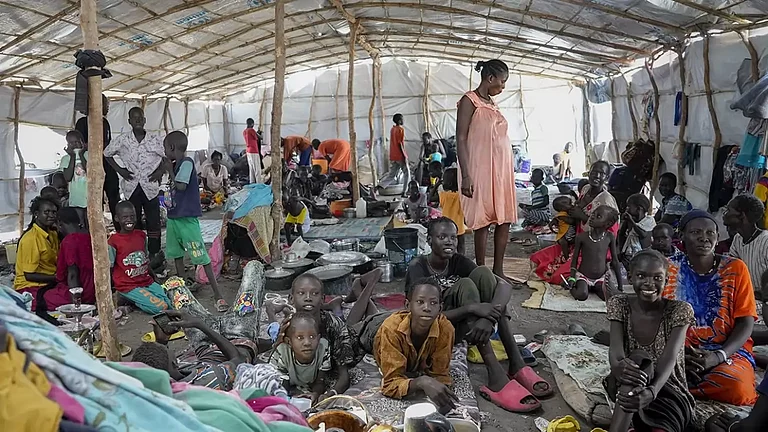Across Africa, millions of children face the harsh realities of war. Their future is often stolen by violence and instability. One of the most shocking examples is the kidnapping of schoolgirls by Boko Haram in Nigeria.
Boko Haram, an extremist group, kidnapped 276 schoolgirls from a secondary school in Chibok, northern Nigeria, in April 2014. The girls, mostly aged between 16 and 18, were abducted while studying for their final exams. This shocking incident drew global attention to the dangers children face in conflict zones. Many of these girls endured horrific experiences; they were sexually abused by soldiers; and, suffered severe violent attacks. Some escaped, but many remain missing, highlighting the ongoing threat to children in war-torn regions.
One such survivor, Margret Yama, was held captive for three years, as reported by The Guardian. She recalls the suffocating conditions in the Sambisa Forest, where food and water were scarce, and they were constantly under watch by their captors. Taunted multiple times with false promises of release, Yama had lost hope. But in May 2017, her life took a turn when a Red Cross convoy arrived on the edges of the forest. She and 81 other girls were finally freed after negotiations between the Nigerian government and Boko Haram. She had survived, but many of her peers still remain missing, a haunting reminder of the ongoing threat to children in conflict zones.
Nigeria’s struggle is not unique. Conflicts in countries like the Democratic Republic of the Congo (DRC), Sudan, and the Central African Republic have also devastated the lives of countless children, robbing them of their childhood.
Children in conflict areas experience unimaginable trauma. They are killed, separation from families and recruited in armed groups. Many are forced to flee, ending up in overcrowded refugee camps or on the streets, where they encounter hunger and disease. The effects of these conflicts extend beyond immediate danger, creating cycles of poverty and instability for generations.
Education, a fundamental right for all children, is often one of the first casualties in conflict zones. Schools are targeted, destroyed or repurposed for military use. As of June 2024, more than 14,000 schools in West and Central Africa have been closed due to violence, impacting the education of hundreds of thousands of children, according to the Norwegian Refugee Council (NRC).
The closure of schools leaves children vulnerable to recruitment by armed groups. With no safe place to learn, many are drawn into cycles of violence, trafficking and exploitation.
“Education is under siege in West and Central Africa. The deliberate targeting of schools and the systemic denial of education because of conflict is nothing short of a catastrophe,” reported the NRC.
The situation is dire in countries like the DRC. Since the beginning of 2024, 1,457 schools have been shut down due to ongoing violence, displacing over 500,000 students and 12,700 teachers.
Armed groups occupy school buildings, using them for military purposes, further disrupting the education system. “Every day that a child is kept out of school is a day stolen from their future and from the future of their communities,” says the NRC.
Healthcare services are also severely affected in conflict zones. War destroys hospitals, clinics and supply chains, leaving millions without access to basic medical care. According to UNICEF, children are 24 times more likely to die from illness or injury during war than during peacetime. Without proper healthcare, diseases like malaria, diarrhoea, and respiratory infections claim more young lives than bullets or bombs.
Malnutrition is rampant in conflict-affected areas, further weakening the children’s immune systems. Displaced families often lack access to food, clean water and sanitation, making children even more vulnerable to diseases.
One of the most horrifying impacts of Africa’s wars is the recruitment of children into armed groups. The brutal reality for these children is a nightmare that begins the moment they are abducted from their homes. In 2023 alone, the DRC saw a shocking 45 per cent increase in child recruitment, with over 1,500 children forced into armed conflict. These young victims, some as young as five, are subjected to unimaginable horrors. Kidnapped, drugged and brainwashed, they endure torturous training and are forced to commit atrocities.
The story of Ishmael Beah captures the gut-wrenching truth of child soldiering. Separated from his family at just 12, Beah was forced to join a splinter military group in Sierra Leone’s civil war. He describes how emotions were stripped away, replaced with violence as a survival mechanism. “Somebody being shot in front of you, or you killing someone became just like drinking a glass of water,” recalls Beah. Any sign of weakness or disobedience was met with ruthless punishment, sometimes even death. Beah witnessed a young boy being shot simply because he cried for his mother.
The toll on child soldiers is not just physical, but deeply emotional. “I met children who survived the horrors of recruitment and the unspeakable trauma of sexual violence―atrocities no one should endure, let alone children,” reported UNICEF’s Director of Child Protection. Many of these children are treated as “disposables” by their commanders, only valuable as long as they can fight. Post-traumatic stress, severe isolation and a lack of basic life skills leave them struggling to reintegrate into society. Stigma and rejection are common, as communities fear the violence these children were forced to commit.
The wars have forced millions of families to flee their homes, creating a massive crisis of internally displaced people (IDPs). According to UNICEF, 6.1 million people in eastern DRC alone have been displaced by violence, with children being the most affected. Displacement camps are often overcrowded and lack basic services like sanitation, clean water and medical care. Children in these camps are vulnerable to trafficking, abuse and exploitation.
Family separation is another tragic consequence of displacement. Many children are orphaned or are separated from their parents during attacks, leaving them at a greater risk of exploitation. Without the protective presence of their families, children are more likely to be detained, abused or recruited by armed groups.




























